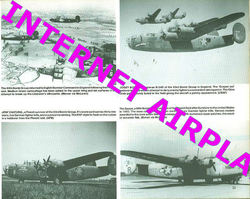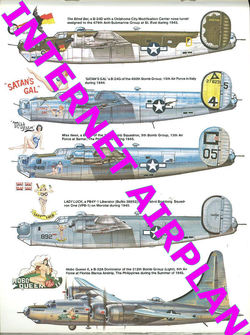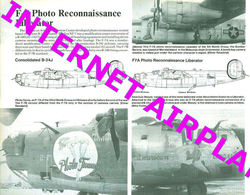---------------------------------------------------------------------------------------------------------------
Additional
Information from Internet Encyclopedia
The Consolidated B-24 Liberator was an
American heavy bomber, designed by Consolidated Aircraft of San Diego,
California. It was known within the company as the Model 32, and a small number
of early models were sold under the name LB-30, for Land Bomber. The B-24 was used in World War II by
several Allied air forces and navies, and by every branch of the American armed
forces during the war, attaining a distinguished war record with its operations
in the Western European, Pacific, Mediterranean, and China-Burma-India
Theaters.
Production of
B-24s increased at an astonishing rate throughout 1942 and 1943. Consolidated
Aircraft tripled the size of its plant in San Diego and built a large new plant
outside Fort Worth, Texas. More B-24s were built by Douglas Aircraft in Tulsa,
Oklahoma. The North American plant B in the city of Grand Prairie, Texas
started production of B-24Gs and B-24J in 1942. None of these were minor
operations, but they were dwarfed by the vast new purpose-built factory
constructed by the Ford Motor Company at Willow Run near Detroit, Michigan.
Ford broke ground on Willow Run in the spring of 1941, with the first plane
coming off the line in October 1942. It had the largest assembly line in the
world (3,500,000 ft²/330,000 m²). At its peak, the Willow Run plant
produced 650 B-24s per month in 1944. By 1945, Ford made 70% of all B-24s in
two nine-hour shifts. Pilots and crews slept on 1,300 cots at Willow Run
waiting for their B-24s to roll off the assembly line. At Willow Run, Ford
produced half of 18,000 total B-24s.
Each of the B-24
factories was identified with a production code: Consolidated/San Diego, CO;
Consolidated/Fort Worth, CF; Ford/Willow Run, FO; North American, NT; and
Douglas/Tulsa, DT.
In 1943, the model
of Liberator considered by many the "definitive" version was
introduced. The B-24H was 10 in (25 cm) longer, had a powered gun
turret in the upper nose to reduce vulnerability to head-on attack, and was
fitted with an improved bomb sight, autopilot, and fuel transfer system.
Consolidated, Douglas and Ford all manufactured the B-24H, while North American
made the slightly different B-24G. All five plants switched over to the almost
identical B-24J in August 1943. The later B-24L and B-24M were lighter-weight
versions and differed mainly in defensive armament.
In all, 18,482
B-24s were built by September 1945. Twelve thousand saw service with the USAAF,
with a peak inventory in September 1944 of 6,043. The U.S. Navy received 977
PB4Y-1s (Liberators originally ordered by the USAAF) and 739 PB4Y-2 Privateers,
derived from the B-24. The Royal Air Force received about 2,100 B-24s equipping
46 bomber groups and 41 squadrons; the Royal Canadian Air Force (RCAF) 1,200
B-24Js; and the Royal Australian Air Force (RAAF) 287 B-24Js, B-24Ls, and
B-24Ms. Liberators were the only heavy bomber flown by the RAAF in the Pacific
Often compared
with the better-known Boeing B-17 Flying Fortress, the B-24 was a more modern
design with a higher top speed, greater range, and a heavier bomb load; it was
also more difficult to fly, with heavy control forces and poor formation-flying
characteristics. Popular opinion among aircrews and general staffs tended to
favor the B-17's rugged qualities above all other considerations in the
European Theater. The placement of the B-24's fuel tanks throughout the upper
fuselage and its lightweight construction, designed to increase range and
optimize assembly line production, made the aircraft vulnerable to battle
damage. The B-24 was notorious among American aircrews for its tendency to
catch fire. Its high fuselage-mounted "Davis wing" also meant it was dangerous
to ditch or belly land, since the fuselage tended to break apart. Nevertheless,
the B-24 provided excellent service in a variety of roles thanks to its large
payload and long range and was the only bomber to operationally deploy the
United States' first forerunner to precision-guided munitions during the war,
the 1,000 lb. Azon guided bomb.
The B-24's most
infamous mission was the low-level strike against the Ploiești oil fields, in Romania on
1 August 1943, which turned into a disaster because the enemy was
underestimated, fully alerted and attackers disorganized.
The B-24 ended
World War II as the most produced heavy bomber in history. At over 18,400
units, half by Ford Motor Company, it still holds the distinction as the
most-produced American military aircraft.
The B-24's
spacious, slab-sided fuselage (which earned the aircraft the nickname
"Flying Boxcar") was built around a central bomb bay that could
accommodate up to 8,000 lb (3,629 kg) of ordnance in each of its
forward and aft compartments. The equal-capacity forward and aft bomb bay
compartments were further split longitudinally with a centerline ventral
catwalk just nine inches (23 cm) wide, which also functioned as the fuselage's
structural keel beam. The occasional need for crewmen to move around inside
from fore to aft within the B-24's fuselage during a mission caused widespread
complaints concerning the extremely narrow catwalk. The B-24 was sometimes disparaged
as "The Flying Coffin" because the only entry and exit from the
bomber was in the rear and it was almost impossible for the flight crew and
nose gunner to get from the flight deck to the rear when wearing parachutes. An
unusual set of tambour-panel "roller-type" bomb bay doors, which
operated very much like the movable enclosure of a rolltop desk, retracted into
the fuselage, creating a minimum of aerodynamic drag to keep speed high over
the target area.
Like the B-17, the
B-24 had an array of .50 caliber (12.7 mm) M2 Browning machine guns in the
tail, belly, top, sides and nose to defend it from attacking enemy fighters.
However, unlike the B-17, the ball turret could be retracted into the fuselage
when not in use, a necessity given the low ground clearance of the fuselage.
The ball turret first appeared on B-24Ds sometime in early 1943 but not before
the early Ds had used tunnel guns and the Bendix remote controlled ventral
turret, also used (unsuccessfully) on the initial B-17E examples and on some
early B-25 Mitchell medium bombers. General use of the ball turrets by the U.S.
would last until late July 1944 when performance gains outweighed the need for
360 degree belly defense. Bomber Command Liberators generally dispensed with
the belly turrets as unnecessary in areas where no enemy fighter presence would
be found.
On 12 June 1942,
13 B-24s flying from Egypt attacked the Axis-controlled oil fields and
refineries around Ploiești, Romania. A total of 177 B-24s carried out the famous
second attack on Ploești (Operation
Tidal Wave) on 1 August 1943, flying from their bases in northwestern Libya. In
late June 1943, the three B-24 Liberator groups of the 8th Air Force were sent
to North Africa on temporary duty with the 9th Air Force. The 44th Bomb Group
was joined by the 93rd and the 389th Bomb Groups. These three units joined the
two 9th Air Force B-24 Liberator groups for the 1 August 1943 low-level attack
on the German-held Romanian oil complex at Ploești. This daring assault by high altitude bombers
at tree top level was a costly success. The 44th destroyed both of its assigned
targets, but lost 11 of its 37 bombers and their crews. Colonel Leon W.
Johnson, the 44th's commander, was awarded the Medal of Honor for his
leadership, as was Col. John Riley Kane, also known as "Killer" Kane,
commander of the 98th Bomb Group. Kane and Johnson survived the mission but
three other recipients of the Medal of Honor for their actions in the
mission—Lt. Lloyd H. Hughes, Maj. John L. Jerstad and Col. Addison E. Baker—were
killed in action. For its actions on the Ploești mission, the 44th was awarded its second
Distinguished Unit Citation. Of the 177 B-24s that were dispatched on this
operation, 54 were lost.
Over the next
three years, B-24 squadrons deployed to all theaters of the war: African,
European, China-Burma-India, the Battle of the Atlantic, the Southwest Pacific
Theater and the Pacific Theater. In the Pacific, the B-24 (and its twin, the
U.S. Navy PB4Y Privateer) was eventually designated as the standard heavy
bomber to simplify logistics and to take advantage of their longer range,
replacing the shorter-range B-17 which had served early in the war along the
perimeter of the Pacific from the Philippines, Australia, Espiritu Santo,
Guadalcanal, Hawaii, and during the Battle of Midway from Midway Island.
While pilots who
flew both preferred the B-17, the B-24 was faster, had longer range, and could
carry a ton more bombs. It was one of the workhorse bombers of the U.S. Eighth
Air Force in the Combined Bomber Offensive against Germany, forming about
one-third of its heavy bomber strength, with the other two-thirds being B-17s.
Thousands of B-24s, flying from bases in England, dropped hundreds of thousands
of tons of high explosive and incendiary bombs on German military and
industrial targets. The 44th Bombardment Group was one of the first two heavy
bombardment groups flying the B-24 with the 8th Air Force in the fall/winter
air campaigns in the European Theater of Operations. The 44th Bomb Group flew
the first of its 344 combat missions against the Axis powers in World War II on
7 November 1942.
B-24s of the Ninth
Air Force, operating from Africa and Italy, and the Fifteenth Air Force, also
operating from Italy, took a major role in strategic bombing. Fifteen of the
15th AF's 21 bombardment groups flew B-24s. The Ninth Air Force moved to
England in 1944 to become a tactical air force, and all of its B-24s were
transferred to other Air Forces, such as the Fifteenth Air Force in Italy.
The first B-24
loss over German territory occurred on 26 February 1943. Earlier in the war,
both the German Luftwaffe and the British Royal Air Force had abandoned
daylight bombing raids because neither could sustain the losses suffered. The
Americans persisted, however, at great cost in men and aircraft. In the period
between 7 November 1942 and 8 March 1943, the 44th Bomb Group lost 13 of its
original 27 B-24s.








